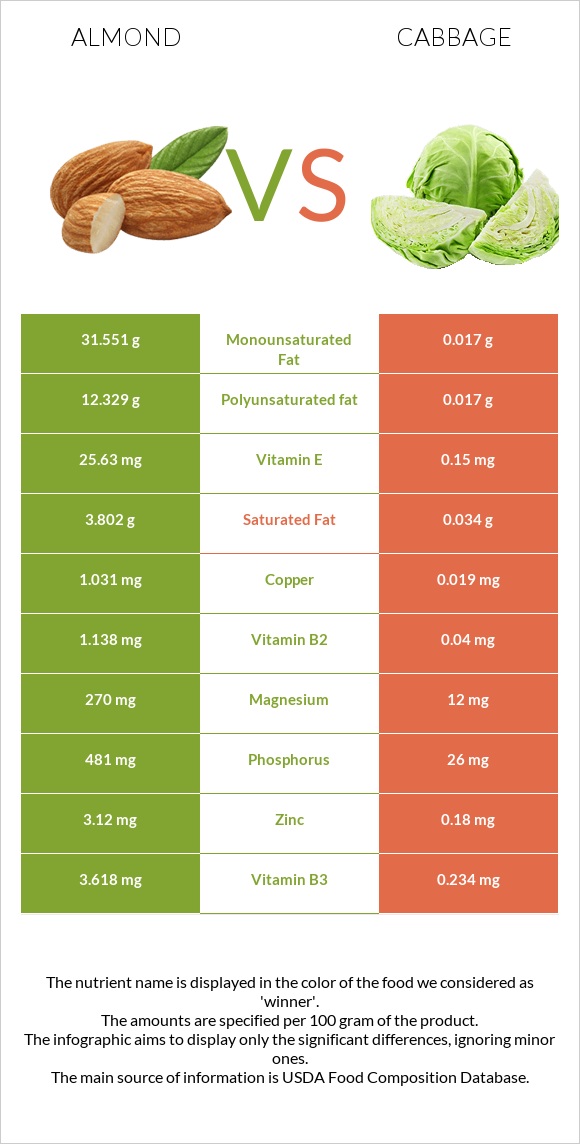Almonds vs. Cabbage — In-Depth Nutrition Comparison
Compare
Significant differences between almonds and cabbage
- Almonds have more vitamin E, copper, manganese, vitamin B2, phosphorus, magnesium, iron, and fiber; however, cabbage is richer in vitamin K and vitamin C.
- Almonds cover your daily vitamin E needs 170% more than cabbage.
- Cabbage has 54 times less copper than almonds. Almonds have 1.031mg of copper, while cabbage has 0.019mg.
Specific food types used in this comparison are Nuts, almonds and Cabbage, raw.
Infographic

Infographic link
Mineral Comparison
Mineral comparison score is based on the number of minerals by which one or the other food is richer. The "coverage" charts below show how much of the daily needs can be covered by 300 grams of the food.
| Contains more MagnesiumMagnesium | +2150% |
| Contains more CalciumCalcium | +572.5% |
| Contains more PotassiumPotassium | +331.2% |
| Contains more IronIron | +689.4% |
| Contains more CopperCopper | +5326.3% |
| Contains more ZincZinc | +1633.3% |
| Contains more PhosphorusPhosphorus | +1750% |
| Contains less SodiumSodium | -94.4% |
| Contains more ManganeseManganese | +1261.9% |
| Contains more SeleniumSelenium | +1266.7% |
Vitamin Comparison
Vitamin comparison score is based on the number of vitamins by which one or the other food is richer. The "coverage" charts below show how much of the daily needs can be covered by 300 grams of the food.
| Contains more Vitamin EVitamin E | +16986.7% |
| Contains more Vitamin B1Vitamin B1 | +236.1% |
| Contains more Vitamin B2Vitamin B2 | +2745% |
| Contains more Vitamin B3Vitamin B3 | +1446.2% |
| Contains more Vitamin B5Vitamin B5 | +122.2% |
| Contains more Vitamin CVitamin C | +∞% |
| Contains more Vitamin AVitamin A | +∞% |
| Contains more Vitamin KVitamin K | +∞% |
All nutrients comparison - raw data values
| Nutrient |  |
 |
DV% diff. |
| Vitamin E | 25.63mg | 0.15mg | 170% |
| Copper | 1.031mg | 0.019mg | 112% |
| Manganese | 2.179mg | 0.16mg | 88% |
| Vitamin B2 | 1.138mg | 0.04mg | 84% |
| Polyunsaturated fat | 12.329g | 0.017g | 82% |
| Monounsaturated fat | 31.551g | 0.017g | 79% |
| Fats | 49.93g | 0.1g | 77% |
| Phosphorus | 481mg | 26mg | 65% |
| Vitamin K | 0µg | 76µg | 63% |
| Magnesium | 270mg | 12mg | 61% |
| Vitamin C | 0mg | 36.6mg | 41% |
| Iron | 3.71mg | 0.47mg | 41% |
| Protein | 21.15g | 1.28g | 40% |
| Fiber | 12.5g | 2.5g | 40% |
| Calories | 579kcal | 25kcal | 28% |
| Zinc | 3.12mg | 0.18mg | 27% |
| Calcium | 269mg | 40mg | 23% |
| Vitamin B3 | 3.618mg | 0.234mg | 21% |
| Potassium | 733mg | 170mg | 17% |
| Saturated fat | 3.802g | 0.034g | 17% |
| Vitamin B1 | 0.205mg | 0.061mg | 12% |
| Choline | 52.1mg | 10.7mg | 8% |
| Selenium | 4.1µg | 0.3µg | 7% |
| Carbs | 21.55g | 5.8g | 5% |
| Vitamin B5 | 0.471mg | 0.212mg | 5% |
| Fructose | 0.11g | 1.45g | 2% |
| Sodium | 1mg | 18mg | 1% |
| Vitamin A | 0µg | 5µg | 1% |
| Vitamin B6 | 0.137mg | 0.124mg | 1% |
| Net carbs | 9.05g | 3.3g | N/A |
| Sugar | 4.35g | 3.2g | N/A |
| Starch | 0.72g | 0g | 0% |
| Folate | 44µg | 43µg | 0% |
| Trans fat | 0.015g | 0g | N/A |
| Tryptophan | 0.211mg | 0.011mg | 0% |
| Threonine | 0.601mg | 0.035mg | 0% |
| Isoleucine | 0.751mg | 0.03mg | 0% |
| Leucine | 1.473mg | 0.041mg | 0% |
| Lysine | 0.568mg | 0.044mg | 0% |
| Methionine | 0.157mg | 0.012mg | 0% |
| Phenylalanine | 1.132mg | 0.032mg | 0% |
| Valine | 0.855mg | 0.042mg | 0% |
| Histidine | 0.539mg | 0.022mg | 0% |
| Omega-3 - ALA | 0.003g | N/A | |
| Omega-6 - Eicosadienoic acid | 0.002g | 0g | N/A |
| Omega-6 - Linoleic acid | 12.32g | N/A |
Macronutrient Comparison
Macronutrient breakdown side-by-side comparison
| Contains more ProteinProtein | +1552.3% |
| Contains more FatsFats | +49830% |
| Contains more CarbsCarbs | +271.6% |
| Contains more OtherOther | +362.5% |
| Contains more WaterWater | +1990.2% |
Fat Type Comparison
Fat type breakdown side-by-side comparison
| Contains more Mono. FatMonounsaturated fat | +185494.1% |
| Contains more Poly. FatPolyunsaturated fat | +72423.5% |
| Contains less Sat. FatSaturated fat | -99.1% |
Carbohydrate type comparison
Carbohydrate type breakdown side-by-side comparison
| Contains more StarchStarch | +∞% |
| Contains more SucroseSucrose | +4837.5% |
| Contains more MaltoseMaltose | +300% |
| Contains more GalactoseGalactose | +∞% |
| Contains more GlucoseGlucose | +882.4% |
| Contains more FructoseFructose | +1218.2% |
~equal in
Lactose
~0g





